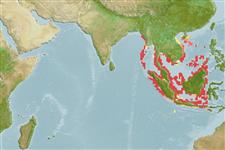Common names from other countries
>
Ovalentaria/misc (Various families in series Ovalentaria) >
Pomacentridae (Damselfishes) > Pomacentrinae
Etymology: Amphiprion: Greek, amphi = on both sides + Greek, prion, -onos = saw (Ref. 45335).
More on author: Bloch.
Environment: milieu / Zona climática / intervalo de profundidade / distribution range
Ecologia
marinhas associadas(os) a recifes; não migratória; intervalo de profundidade 2 - 15 m (Ref. 9710). Tropical; 20°N - 11°S, 91°E - 119°E
Eastern Indian Ocean: Andaman and Nicobar Islands, Thailand, Malaysia, and Java and Sumatra in Indonesia.
Tamanho / Peso / Idade
Maturidade: Lm ? range ? - ? cm
Max length : 14.0 cm TL macho/indeterminado; (Ref. 9710); idade máx. registrada: 16 anos (Ref. 72479)
Descrição suscinta
Chaves de identificação | Morfologia | Morfometria
Espinhos dorsais (total) : 10 - 11; Raios dorsais (total) : 16 - 18; Espinhos anais: 2; Raios anais : 13 - 14.
Body shape (shape guide): short and / or deep; Cross section: compressed.
Adults are found in silty coastal waters and protected bays where visibility is often reduced. Usually found in pairs (Ref. 48636). Oviparous, distinct pairing during breeding (Ref. 205). Eggs are demersal and adhere to the substrate (Ref. 205). Males guard and aerate the eggs (Ref. 205). Associated with the anemones: Entacmaea quadricolor and Heteractis crispa (Ref. 5911). Has been reared in captivity (Ref. 35413, 35420).
Ciclo de vida ou comportamento de acasalamento
Maturidade | Reprodução | Desova | Ovos | Fecundidade | Larvas
Oviparous, distinct pairing during breeding (Ref. 205). Eggs are demersal and adhere to the substrate (Ref. 205). Males guard and aerate the eggs (Ref. 205). Also Ref. 7471.
Allen, G.R., 1991. Damselfishes of the world. Mergus Publishers, Melle, Germany. 271 p. (Ref. 7247)
Status na Lista Vermelha da UICN (Ref. 130435: Version 2025-1)
Ameaça para os humanos
Harmless
Uso pelos humanos
Pescarias: espécies comerciais; Aquário: Espécies comerciais
Ferramentas
Relatórios especiais
Baixar XML
Fontes da internet
Estimates based on models
Preferred temperature (Ref.
123201): 28.4 - 29.3, mean 28.9 °C (based on 593 cells).
Índice de diversidade filogenética (Ref.
82804): PD
50 = 0.5000 [Uniqueness, from 0.5 = low to 2.0 = high].
Bayesian length-weight: a=0.02344 (0.01134 - 0.04848), b=2.98 (2.80 - 3.16), in cm total length, based on LWR estimates for this (Sub)family-body shape (Ref.
93245).
Nível Trófico (Ref.
69278): 2.7 ±0.31 se; based on food items.
Resiliência (Ref.
120179): Elevada, tempo mínimo de duplicação da população menor que 15 meses (Preliminary K or Fecundity.).
Fishing Vulnerability (Ref.
59153): Low vulnerability (10 of 100).
🛈
Nutrients (Ref.
124155): Calcium = 97.4 [49.9, 153.2] mg/100g; Iron = 0.717 [0.437, 1.159] mg/100g; Protein = 18.3 [17.1, 19.4] %; Omega3 = 0.103 [0.063, 0.165] g/100g; Selenium = 21.7 [12.4, 40.6] μg/100g; VitaminA = 81.3 [23.0, 265.6] μg/100g; Zinc = 1.67 [1.14, 2.41] mg/100g (wet weight);
